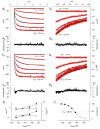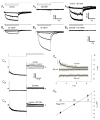Ih without Kir in adult rat retinal ganglion cells
- PMID: 17488978
- PMCID: PMC3241988
- DOI: 10.1152/jn.01241.2006
Ih without Kir in adult rat retinal ganglion cells
Abstract
Antisera directed against hyperpolarization-activated mixed-cation ("I(h)") and K(+) ("K(ir)") channels bind to some somata in the ganglion cell layer of rat and rabbit retina. Additionally, the termination of hyperpolarizing current injections can trigger spikes in some cat retinal ganglion cells, suggesting a rebound depolarization arising from activation of I(h). However, patch-clamp studies showed that rat ganglion cells lack inward rectification or present an inwardly rectifying K(+) current. We therefore tested whether hyperpolarization activates I(h) in dissociated, adult rat retinal ganglion cell somata. We report here that, although we found no inward rectification in some cells, and a K(ir)-like current in a few cells, hyperpolarization activated I(h) in roughly 75% of the cells we recorded from in voltage clamp. We show that this current is blocked by Cs(+) or ZD7288 and only slightly reduced by Ba(2+), that the current amplitude and reversal potential are sensitive to extracellular Na(+) and K(+), and that we found no evidence of K(ir) in cells presenting I(h). In current clamp, injecting hyperpolarizing current induced a slowly relaxing membrane hyperpolarization that rebounded to a few action potentials when the hyperpolarizing current was stopped; both the membrane potential relaxation and rebound spikes were blocked by ZD7288. These results provide the first measurement of I(h) in mammalian retinal ganglion cells and indicate that the ion channels of rat retinal ganglion cells may vary in ways not expected from previous voltage and current recordings.
Figures




Similar articles
-
Transient and sustained depolarization of retinal ganglion cells by Ih.J Neurophysiol. 1996 May;75(5):1932-43. doi: 10.1152/jn.1996.75.5.1932. J Neurophysiol. 1996. PMID: 8734592
-
Expression of a functional hyperpolarization-activated current (Ih) in the mouse nucleus reticularis thalami.J Neurophysiol. 2006 May;95(5):3073-85. doi: 10.1152/jn.00922.2005. J Neurophysiol. 2006. PMID: 16617177
-
Voltage-dependent conductances of solitary ganglion cells dissociated from the rat retina.J Physiol. 1987 Apr;385:361-91. doi: 10.1113/jphysiol.1987.sp016497. J Physiol. 1987. PMID: 2443669 Free PMC article. Review.
-
Upregulation of the hyperpolarization-activated cation current after chronic compression of the dorsal root ganglion.J Neurosci. 2003 Mar 15;23(6):2069-74. doi: 10.1523/JNEUROSCI.23-06-02069.2003. J Neurosci. 2003. PMID: 12657665 Free PMC article.
-
Activation of dopamine D1 receptors enhances the temporal summation and excitability of rat retinal ganglion cells.Neuroscience. 2017 Jul 4;355:71-83. doi: 10.1016/j.neuroscience.2017.04.046. Epub 2017 May 10. Neuroscience. 2017. PMID: 28499973
Cited by
-
Muscarinic acetylcholine receptor localization and activation effects on ganglion response properties.Invest Ophthalmol Vis Sci. 2010 May;51(5):2778-89. doi: 10.1167/iovs.09-4771. Epub 2009 Dec 30. Invest Ophthalmol Vis Sci. 2010. PMID: 20042645 Free PMC article.
-
Restoring visual function to blind mice with a photoswitch that exploits electrophysiological remodeling of retinal ganglion cells.Neuron. 2014 Feb 19;81(4):800-13. doi: 10.1016/j.neuron.2014.01.003. Neuron. 2014. PMID: 24559673 Free PMC article.
-
Inhibition of a cyclic nucleotide-gated channel on neuronal cilia activates unfolded protein response in intestinal cells to promote longevity.Proc Natl Acad Sci U S A. 2024 Jun 18;121(25):e2321228121. doi: 10.1073/pnas.2321228121. Epub 2024 Jun 10. Proc Natl Acad Sci U S A. 2024. PMID: 38857399 Free PMC article.
-
Colocalization of hyperpolarization-activated, cyclic nucleotide-gated channel subunits in rat retinal ganglion cells.J Comp Neurol. 2011 Sep 1;519(13):2546-73. doi: 10.1002/cne.22638. J Comp Neurol. 2011. PMID: 21456027 Free PMC article.
-
The effect of morphology upon electrophysiological responses of retinal ganglion cells: simulation results.J Comput Neurosci. 2014 Apr;36(2):157-75. doi: 10.1007/s10827-013-0463-7. Epub 2013 Jul 9. J Comput Neurosci. 2014. PMID: 23835760 Free PMC article.
References
-
- Akamine T, Nishimura Y, Ito K, Uji Y, Yamamoto T. Effects of haloperidol on K+ currents in acutely isolated rat retinal ganglion cells. Invest Ophthalmol Vis Sci. 2002;43:1257–1261. - PubMed
-
- Akopian A, Witkovsky P. D2 dopamine receptor-mediated inhibition of a hyperpolarization-activated current in rod photoreceptors. J Neurophysiol. 1996;76:1828–1835. - PubMed
-
- Ames A, 3rd, Nesbett FB. In vitro retina as an experimental model of the central nervous system. J Neurochem. 1981;37:867–877. - PubMed
-
- Barres BA, Silverstein BE, Corey DP, Chun LL. Immunological, morphological, and electrophysiological variation among retinal ganglion cells purified by panning. Neuron. 1988;1:791–803. - PubMed
-
- Bayliss DA, Viana F, Bellingham MC, Berger AJ. Characteristics and postnatal development of a hyperpolarisation-activated inward current in rat hypoglossal motoneurones in vitro. J Neurophysiol. 1994;71:119–128. - PubMed
Publication types
MeSH terms
Substances
Grants and funding
LinkOut - more resources
Full Text Sources
Miscellaneous

